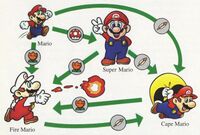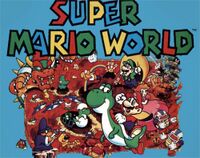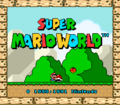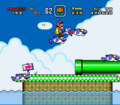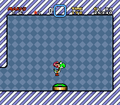Welcome to Mariopedia! If you want an account, please request it over at Mario Wiki, Italia Wiki, Gabe the Slacker Wiki, or Fanonpedia.
Super Mario World
- This article is about the video game for the Super Nintendo Entertainment System. For information about other uses, see Super Mario World (disambiguation).
- "SMW" redirects here. For information about the game known as "Super Mario Wii" in South Korea, see Super Mario Galaxy.
| Super Mario World | |||||||||
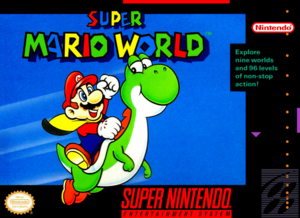
| |||||||||
| Developer | Nintendo EAD | ||||||||
| Publisher | Nintendo | ||||||||
| Platform(s) | Super Famicom / Super Nintendo Entertainment System, Nintendo Super System, Virtual Console (Wii, Wii U, New Nintendo 3DS), Super NES Classic Edition/Super Famicom Mini, Super Nintendo Entertainment System - Nintendo Switch Online | ||||||||
| Release date | SNES: Nintendo Super System: Virtual Console (Wii): Virtual Console (Wii U): Virtual Console (New 3DS): Super NES Classic Edition: Super Nintendo Entertainment System - Nintendo Switch Online: Give the world a whole new look! | ||||||||
| Language(s) | English (United States) Japanese | ||||||||
| Genre | Platformer, action-adventure | ||||||||
| Rating(s) |
| ||||||||
| Mode(s) | Single player, multiplayer | ||||||||
| Media | SNES: Wii: Wii U: Nintendo Switch: Nintendo 3DS: SNES Classic Edition:
Built-in
| ||||||||
| Input | Super NES: Wii: Wii U: Nintendo Switch: Nintendo 3DS: SNES Classic Edition:
| ||||||||
Super Mario World (originally known in Japan as Super Mario World: Super Mario Bros. 4) is a Super Mario series title and launch title released for the Super Famicom in 1990, then for its overseas counterpart, the Super Nintendo Entertainment System, in 1991 in North America and in 1992 in Europe and Australia. The game was produced by Shigeru Miyamoto, featuring music composed by Koji Kondo, and graphics designed by Shigefumi Hino. An updated version has been released on the Game Boy Advance. The original version was also re-released on the Wii and later Wii U Virtual Console. This is the Mario game in which Yoshi, Wigglers, Monty Moles, Swoopers, and Magikoopas made their debuts, and a save feature has been added.
The game was followed in 1995 by the prequel, Super Mario World 2: Yoshi's Island, which takes place several years before the events in Super Mario World. Yoshi's Island spawned its own series of sequels.
Shigeru Miyamoto has stated that ever since they finished Super Mario Bros., the design staff wanted to have Mario ride a dinosaur. It was believed to be impossible technically until the Super NES was developed. According to Miyamoto, sixteen people were involved in the creation of the game, and it took about three years to make.[8] At some point during the game's development, it was meant to be released in North America and Europe as Super Mario World: Super Mario Bros. 4 or Super Mario World: Super Mario Bros., but it was later shortened to Super Mario World.[9][10] Miyamoto has stated that this is his favorite Mario game.
In addition to the game itself, there is a cartoon series that is based on the game which debuted on September 14, 1991, one month after the American release. The series takes place in Dome City, and is produced by DiC Entertainment and Nintendo.
Story
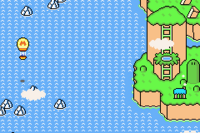
General
After the events of Super Mario Bros. 3, Mario and Princess Toadstool go on a vacation to Dinosaur Land by hot air balloon. When Mario and the Princess arrive, Luigi is there waiting for them with a Cape. He gives Mario a Feather, turning him into Cape Mario. They fly around Dinosaur Land with their capes.
Meanwhile, Bowser and his Koopalings trap Yoshi's friends in eggs and kidnap Princess Toadstool. When Mario and Luigi return they find that she is missing again, so they set out to save her with the help of the Yoshis and Dolphins.
As Mario travels through Dinosaur Land, he gets to Valley of Bowser. After defeating Larry, he has access to Bowser's Castle. He fights Bowser and his Koopa Clown Car and saves Princess Toadstool. The team returns to Yoshi's House where they and other Yoshis watch the Yoshi Eggs hatch.
From the instruction booklet
After saving the Mushroom Kingdom from Bowser and the rest of the Koopas in Super Mario 3, Mario and Luigi needed to recuperate from their adventures. Together they agreed that the best place to vacation was a magical place called Dinosaur Land.
But while Mario and Luigi reclined on the beach for a relaxing nap, Princess Toadstool disappeared, apparently seized by evil forces. After searching for hours for their missing friend, Mario and Luigi came upon an enormous egg in the forest.
Suddendly the egg hatched, and out popped a young dinosaur named Yoshi, who proceeded to tell Mario and Luigi a sad tale of how his dinosaur pals were sealed in similar eggs by a group of monstrous turtles.
"Monstrous turtles!," exclaimed Luigi. "Bowser and his bunch have returned!" Mario slowly nodded his head in agreement and, along with Luigi and Yoshi, set off across Dinosaur Land to find the Princess and to free Yoshi's friends. As they began their journey, Yoshi handed Mario a beautiful cape. "This may help you," Yoshi said. "Some say it has magical powers."
With a little luck (and help from a magic cape), our hearty crew can defeat the seven worlds of Bowser's Krazy Koopa Kritters. Many locations are well-hidden so explore everywhere and try everything. Not all locations have to be explored to rescue the dinosaurs and save Princess Toadstool, but there are many "starry" treasures to be found in far-reaching places. You'll need to search all areas to find what kinds of treasures are there… in Super Mario World.
Gameplay
The object of the game is to get to the goal tape to advance to the next level. While on Mario's way to the goal, he must encounter many enemies and collect power-ups and use items to help solve puzzles and destroy enemies.
Controls
: Spin jump
: Jump
/
: Dash/Interact/Special ability
 :Scroll camera left
:Scroll camera left :Scroll camera right
:Scroll camera right:Pause
:Use item/Return to map (When paused)
Power-Ups
| Image | Name | Description |
|---|---|---|
| Super Mushroom | Grab this to change into Super Mario. | |
| Fire Flower | Grab this to change into Fire Mario. | |
| Cape Feather | Grab this to change into Caped Mario. | |
| P-Balloon | If Mario or Luigi collects one of these, they will inflate like balloons and will be able to float in the air for a short time. No points collected upon collecting the item. | |
| Star | When collected, either Mario or Luigi (depending on who gets it) will become temporarily invincible. If the players collects more stars in blocks when they have it already, they can stay invincible for a bit longer. 1000 points collected. | |
| Yoshi's Wings | If Yoshi grabs these wings, he will enter Coin Heaven. It will also turn any Yoshi blue after completion, making this an easier way to get a Blue Yoshi before Star World. |
Items
| Image | Name | Description |
|---|---|---|
| 1-Up Mushroom | If Mario or Luigi collects one, they'll get an extra life. 100 points collected. | |
| 3-Up Moon | If Mario or Luigi collects one of these very rare items, they both get three extra lives. 300 points collected. | |
| Coin | Collect 100 Coins for a 1-Up. | |
| Dragon Coin | Collect all five or more on one stage for a 1-Up. | |
| Key and Keyhole | If Mario or Luigi grab the key and put it in a keyhole (which is hidden in a level), a secret level will be unlocked. | |
| P-Switches | When the blue switch is pressed, blocks transform into coins and vice-versa, and some invisible blocks will be revealed. If the silver one is pressed, some enemies, such as Spinies, will transform into Silver Coins. After a short period of time, the changes made by either switch will revert to normal. | |
| ? Ball | An item that is required to successfully complete the Sunken Ghost Ship. | |
| Baby Yoshi | If Mario or Luigi passes nearby a lone Yoshi Egg, it will hatch into a Baby Yoshi. The player must feed the Baby Yoshi five enemies or one powerup to grow into an Adult Yoshi. Every time a Baby Yoshi eats an enemy, the player will receive a coin and 200 points. |
Worlds
- Yoshi's Island (Iggy Koopa)
- Donut Plains (Morton Koopa Jr.)
- Vanilla Dome (Lemmy Koopa)
- Twin Bridges (Ludwig von Koopa)
- Forest of Illusion (Roy Koopa)
- Chocolate Island (Wendy O. Koopa)
- Valley of Bowser (Larry Koopa and Bowser)
Bonus worlds
If Mario and/or Luigi accumulate 100 stars by touching the flag at the finish, they play a bonus game where they hit blocks. Eight random blocks travel around a block that already has a determined power-up. Power-ups include Super Mushrooms, Fire Flowers, and Stars. Mario/Luigi can only hit blocks while they are at the bottom, and hit blocks continue to travel around the center (while retaining the hit power-up). Once the last block is hit, the blocks stop traveling and 1-ups are awarded. The number of 3-in-a-row matches determines the number of 1-Ups the player will receive (up to a maximum of 8).
Characters
Mario (and, in 2-Player mode, Luigi) are the main playable characters. If Mario loses a life or completes a level in 2-Player mode, Luigi comes into play until he does the same. The two may also share Extra Lives on the world map. Unlike in some other Mario games, both of the plumbers possess the same strengths and weaknesses.
Colored Yoshis
In addition to Mario and Luigi, Yoshis of four different colors appear in the game, which may be controlled once acquired and help the Mario Bros. in many levels of the game:
| Sprite | Name | Description |
|---|---|---|
| Green Yoshi | The default Yoshi. Like the other Yoshis, it is able to eat many kinds of enemies and jump on spiked enemies without taking harm as well as walk across Munchers. They can also utilize Shells for special powers, but unlike the other Yoshis, the color of the Shell but not a specific Yoshi power to pair with it. | |
| Red Yoshi | A Yoshi that spits out all Shells in the form of three fireballs. By spitting the shell out, Red Yoshi loses this power. | |
| Blue Yoshi | A Yoshi that flies if a Shell is in its mouth. | |
| Yellow Yoshi | A Yoshi that can shake the ground by taking a Shell into its mouth, defeating enemies with its impact. |
Green Yoshis hatch out of Yoshi Eggs, usually found in various blocks throughout the game. If a Yoshi Egg is found but the player already has a Yoshi, the Egg will instead provide an 1-Up Mushroom. Red, blue and yellow Yoshis are extremely rare in Super Mario World. They live only in the Star World, a mysterious place accessible by using the five Star Roads found throughout the game. When they are first encountered, they are Baby Yoshis, small and are unable to be rode, but through carrying them, the baby Yoshi's will eat the enemies they touch. When 5 enemies are eaten, they will transform into adult Yoshi's, and can now be used normally. Baby Yoshis of all colors hatch from the Yoshi Eggs rescued from the castles, during the ending credits of the game.
In the GBA remake, the color of the Yoshi that will hatch depends from the power up the player has:
- Random for Small Mario or when the colored Yoshi corresponding to the current powerup isn't rescued yet.
- Yellow for Super Mario.
- Red for Fire Mario.
- Blue for Cape Mario.
Enemies
Bosses
Secret bonus changes
After the player beats every special level in Super Mario World, or opens all 96 exits in Super Mario World: Super Mario Advance 2, the following changes occur:
- World map: The colors of the map become fall-themed, like grass and the trees of Forest of Illusion turning orange.
- Koopa Troopas and Koopa Traratroopas: Transform into Mask Koopas and Para Mask Koopas, respectively.
- Piranha Plants and Jumping Piranha Plants: Change into Pumpkin Plants and Jumping Pumpkin Plants, respectively.
- Vines: Heads will turn into pumpkins.
- Bullet Bills: Replaced with Pidgit Bills.
- Goombas: Become yellowish and have sunglasses. (In Super Mario World: Super Mario Advance 2 only)
- Pokeys: Turn into sawblade-like creatures. (In Super Mario World: Super Mario Advance 2 only)
Remakes and ports
Super Mario All-Stars + Super Mario World
- Main article: Super Mario All-Stars + Super Mario World
Super Mario World: Super Mario Advance 2
- Main article: Super Mario World: Super Mario Advance 2
Super Mario World was ported to the Game Boy Advance handheld system as the second installation in the Super Mario Advance series, Super Mario World: Super Mario Advance 2. Some of the more notable changes are new Luigi's sprite, the new amount of 999 lives that can now be saved, and the list of levels showing whether the secret exit and the Yoshi Coins have been found.
Notable mistakes and errors
Graphical
- Several graphical errors are present in the game. Of note is that the Magikoopas' unique palette has their colors ordered incorrectly, resulting in the area that should be occupied by the lightest shade of blue instead having the darkest. This is fixed in the Game Boy Advance version by giving them the normal blue palette.
- The Koopa bosses are all depicted with three fingers on each hand. This is fixed in the GBA version. Most of the Koopalings' sprites are made to resemble their Super Mario Bros. 3 counterparts (likely to be more easy to recognize), even when the result would be off-model from their artwork, such as with Iggy having only one tooth and Wendy having a white bow with red spots.
- Morton, Roy, and Ludwig are given green, blue, and yellow palettes, respectively, in gameplay. In the credits, they are given turquoise, gray, and pink palettes, respectively. However, in order to match up with their Super Mario Bros. 3 palettes, they should be given the gray, pink, and turquoise palettes, respectively. The credits also give Ludwig Morton's teeth.
- Lemmy is depicted as being yellow and has large fangs and spikeless arm cuffs, likely owing to having the same body as Wendy to conserve graphic space.
- Iggy is accidentally given Larry's hair, leaving Iggy's unused except for in the credits. This error remains in the GBA version. Iggy is also incorrectly blue.
- Bowser is depicted as being primarily green. This is fixed in the GBA version to make him primarily orange. In addition, he lacks the spiked cuffs on his arms. This error is kept in the GBA version. Bowser's sprite was redesigned in the Super Mario World theme of Super Mario Maker.
- Yoshi's arms are orange, as are those of the rest of his species.
- Due to how Chargin' Chucks' graphics are assembled, their graphics have many errors. Most conspicuously, their heads come off for a frame when they are hit. Other errors include their facemasks going behind the rim of their plastrons in certain poses, and the facemasks also being visible in front of the clapping effect. They are also assigned a green palette in-game despite being colored with blue highlights in their artwork and being given a blue palette in the credits. However, when running, their shoulders have a blue palette very briefly. They also have a star in their artwork, which is absent in their sprites.
- Despite Dry Bones being skeletal Koopa Troopas, they are depicted as being far larger than their living counterparts. They also have neck and arm bones in their sprites but not their artwork.
- The two lower tiles on the back-facing climbing Koopas appear to be switched, as the lower part of the shell moves in the opposite direction as the upper part of it, and the limbs are not oriented as they are in the front-facing sprites.
- Spike Tops are seemingly depicted with six legs in the game, despite seemingly having four in their artwork. This is retained in the Super Mario Maker games.
- Despite being given green feet in their artwork, Goombas are assigned the yellow palette in-game, with the yellow only affecting their feet anyway.
- Monty Moles have incompatible designs between their jumping and running sprites, with the former having a split lip and the latter having a smooth curve for a mouth. The GBA remake continues this with Mega Mole's unique defeat sprite seen by having Yoshi eat one while playing as Luigi.
- Due to how Mechakoopas' tiles are assembled, the sprite of one getting up from being stunned appears to have half of an extra lower jaw under its full jaw and half of an extra foot over its full foot.
- Big Boos have lower fangs and white eyes in their sprites, but they have the same faces as normal Boos in their artwork.
- Bony Beetles have the same falling-apart animation as Dry Bones, with Dry Bones' heads being particularly conspicuous.
Miscellaneous
- In the Japanese version, the message spelled out with coins in Funky reads "YOU ARE SUPER PLAYER!!" in a typical case of Engrish. The Western versions fix the grammar to "YOU ARE A SUPER PLAYER!!" thus adding more coins to the level.
- The English localization refers to the enemy known as Kuribon in Japan as "Goomba," either in an accidental mistranslation or a deliberate attempt to group the two creatures together, possibly to seem more familiar to players. This led to confusion in Western depictions as to whether or not the two creatures were the same thing until Super Mario 3D World retranslated them as "Galoombas," though Mario Party Advance seemingly made an earlier attempt with "Goombob."
References to other games
- Super Mario Bros. 2 - A few enemies from this game (Ninjis, Pidgits) appear, bringing them into the proper Mario Universe, as they were from a dream world in this game. Also, since Super Mario Bros. 2 was just a remake of Yume Kōjō: Doki Doki Panic, this introduced them as proper Mario enemies as well.
- Super Mario Bros. 3 - The Sunken Ghost Ship was once an airship from this game. Also all of the Koopalings return here.
References in later games
- Mario Roulette - Many sounds and graphics from here appear in this game.
- Mario Paint - Many sounds and graphics from here appear in this game.
- Super Mario Kart - Lakitu is near identical in appearance in this game and many tracks in this game are based on levels here.
- Mario's Time Machine - Many sounds and graphics from here appear in this game.
- Mario is Missing! - Many sounds and graphics from here appear in this game.
- Super Mario World 2: Yoshi's Island - This game is a prequel to Super Mario World, though the stories are practically unrelated in sharing some settings and uses Yoshi as the main character, although there are nine Yoshis (or ten in the Game Boy Advance remake) for each stage for each zone.
- Super Mario RPG: Legend of the Seven Stars - The Star Road found here is destroyed by Exor and it is revealed that Geno is from here. Yoshi's Island also returns as Yo'ster Isle, and a rendition of the overworld music from this game plays upon first meeting Gaz. Also, the overworld theme music can be heard while singing a Character to sleep.
- Super Mario 64 - The idea of Switch Palaces is, in a way, carried over into this game.
- Paper Mario - The underwater theme from the level "Donut Secret 1" is remixed and used as the theme for this game's title screen.
- Super Smash Bros. Melee - There is a Super Mario World themed level called Yoshi's Island. Banzai Bill also returns, and Mario can use his cape as his Side + B move. Trophies of the Koopa Clown Car and Mario riding Yoshi are collectible.
- Mario & Luigi: Superstar Saga - In a room in Woohoo Hooniversity, four question blocks from previous games (the names of which are even stated in their descriptions) can be seen. One of them is the question block from Super Mario World.
- Super Mario Sunshine - When F.L.U.D.D. scans Mario, a video of Mario battling Iggy in this game can be seen.
- Mario Party Advance - The results screen music after the player runs out of Mushrooms in this game is a remix of the overworld theme from Super Mario World. Goombas also appeared in the form they appeared in the game, as well.
- Super Smash Bros. Brawl - A short demo of Super Mario World is playable, and the Yoshi's Island stage returns. Mario's cape move returns from Melee as well. Also, Bowser uses his Koopa Clown Car in the Subspace Emissary. Finally, the Title Theme and Ending Theme are both remixed and played on the Delfino Plaza stage, as well as the Castle Theme on the Luigi's Mansion stage. Yoshi's Wings are also apart of Yoshi's Final Smash.
- New Super Mario Bros. Wii - Yoshi reappears in this game, behaving exactly as he did in Super Mario World. The Spin Jump also makes a return.
- Super Mario Galaxy 2 - A remix of the background music from the Ghost House stages is used for Haunty Halls Galaxy and a remix of the athletic theme is used in Hightail Falls Galaxy. Sound effects from Super Mario World are re-used, such as the sound when Yoshi is mounted, when a door is opened and when the P-Switch time limit (the Teleporter time limit in this game) is about to run out. Yoshi reappears, also having different colors (only with power-ups). Yoshi's House also returns in the Sky Station Galaxy.
- New Super Mario Bros. 2 - Reznors returns in this game, as well as the remix of the battle theme. Also, the chime that can be heard while the game loads sometimes plays a small part of the Super Mario World overworld theme and in World 4, Super Mario World's snow level background is reused.
- New Super Mario Bros. U - This game seems to be based off Super Mario World, with similar backgrounds and level styles. Baby Yoshis reappear as well. It also uses a single, continuous world map, similar to this game.
Beta elements
- Main article: List of Super Mario World beta elements
Dinosaur Land was drastically different than the final version, possessing an appearance similar to the various kingdoms of Super Mario Bros. 3. Specifically, it was to feature things such as Toad Houses (which could possibly mean that Toads were once considered to populate Dinosaur Land) and more Super Mario Bros. 3-style Fortresses. In addition to this, the game originally had the subtitle "Super Mario Bros. 4"
Glitches
- Main article: List of glitches in Super Mario World
Glitchy Graphics from Defeated Enemies
The balls on Iggy's and Larry's platforms can be destroyed by the sliding attack, as can the Grinders (using a triangle block). This results in glitchy graphics, most likely because the developers did not intend for these enemies to be defeated. The same thing happens if Mario does a nose diving in the second level of the Bowser battle. The Big Steely will be defeated as the head of Princess Toadstool colored red.
Miscolored Overworld
In order to do this glitch, the player must go to the end of Chocolate Island 3. Under the goal, the player must jump off Yoshi to the Giant Gate so that the screen does not scroll up. If done correctly, Mario is barely seen when he finishes the level, and because Mario is not present on the bottom of the screen, the screen begins to flicker in many colors as the stage begins to fade out. When he comes back to the overworld map, the entire world is glitchy and colored with red and blue. If Mario visits Forest of Illusion or Valley of Bowser and comes back to the main overworld, the entire world will be ivory colored instead. The glitch ends if the player completes a level or visits Star Road.
Critical reception
The game was placed 16th in the 100th issue of Nintendo Power's "100 best Nintendo games of all time" in 1997.[11] The game placed 47th in the 200th Issue of GameInformer's "Top 200 Games of All Times".
Super Mario World was bundled with the Super Nintendo Entertainment System making it the most sold game for SNES, selling 20 million copies.
IGN rated the original version as 8.5/10 and the Game Boy Advance remake as 9.3/10. Allgame rated it 5 stars.
Staff
- Main article: List of Super Mario World staff
Main Director
Map Director
Area Director
- Katsuya Eguchi
Program Director
- Toshihiko Nakago
Gallery
- For this subject's image gallery, see Super Mario World/gallery.
Mario and Yoshi smashing the Green Switch in Green Switch Palace.
Bowser in his Koopa Clown Car
Two Paragoombas
Trivia
- None of the Koopalings' sprites are the correct color of their game artwork, except for Larry. All of their in-game colors are the colors of the Koopa Troopas of Super Mario World, with the colors going from yellow, to blue, to red, to green, from oldest Koopaling to youngest.
- Some of the game's levels are featured on its larger area world map, this includes the levels of Worlds 2, 4 and 6 (Donut Plains, Twin Bridges and Chocolate Island, respectively) while others are featured on more specific world maps.
- This is the first game where Koopa Troopas and Paratroopas stand on two legs instead of four, and wear shoes.
- The Super Mario All-Stars remake of Super Mario World gave Luigi a more distinctive sprite where he is taller, thinner and animates differently, whilst in the original he is almost identical to Mario with a palette swap.
- The Forest of Illusion can only be completed by finding the secret exit in the third level.
- This is the second Super Mario title not to feature Toad.
References
- ^ Super Smash Bros. for Wii U Masterpieces
- ^ Date info of Super Mario World (SNES) from TMK, retrieved 4/1/2008
- ^ Arcade flyer
- ^ Nintendo (September 4, 2019). Nintendo Direct 9.4.2019. YouTube. Retrieved September 4, 2019.
- ^ Nintendo (September 4, 2019). Nintendo Direct 2019.9.5. YouTube. Retrieved September 4, 2019.
- ^ Tweet by Nintendo of Europe (Super Nintendo Entertainment System - Nintendo Switch Online release date). Twitter. Retrieved September 4, 2019.
- ^ Tweet by Nintendo AU NZ (Super Nintendo Entertainment System - Nintendo Switch Online release date). Twitter. Retrieved September 4, 2019.
- ^ Interview with Shigeru Miyamoto in Mario Mania Player's Guide, p. 32.
- ^ This local news segment displays the Super Mario World title screen with the "Super Mario Bros." subtitle., retrieved 8/11/2011
- ^ This local news segment displays the Super Mario World title screen with the "Super Mario Bros. 4" subtitle., retrieved 8/11/2011
- ^ http://www.gamekult.com/communaute/forum/voirmessage.html?foid=13000909, retrieved 6/4/2009
